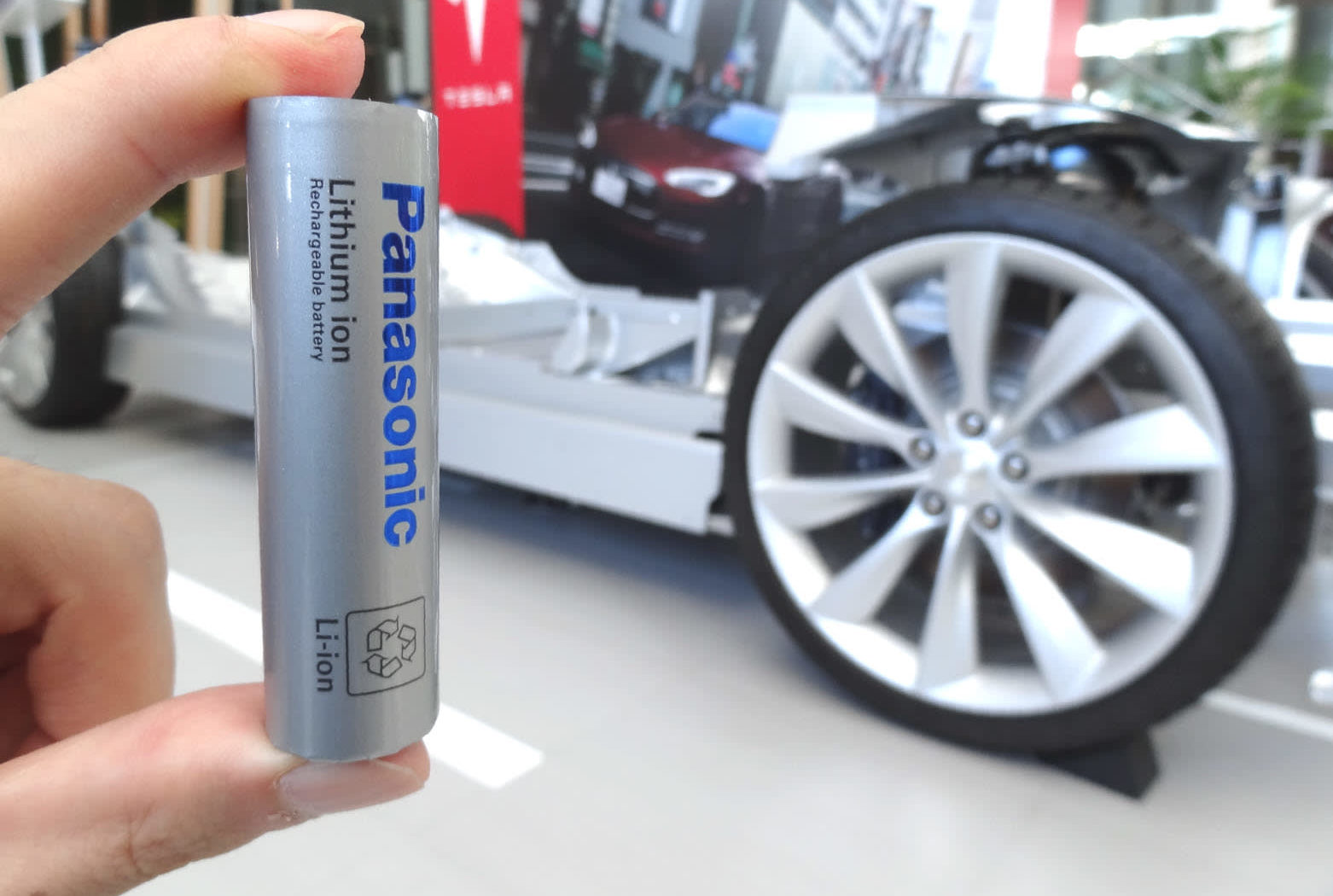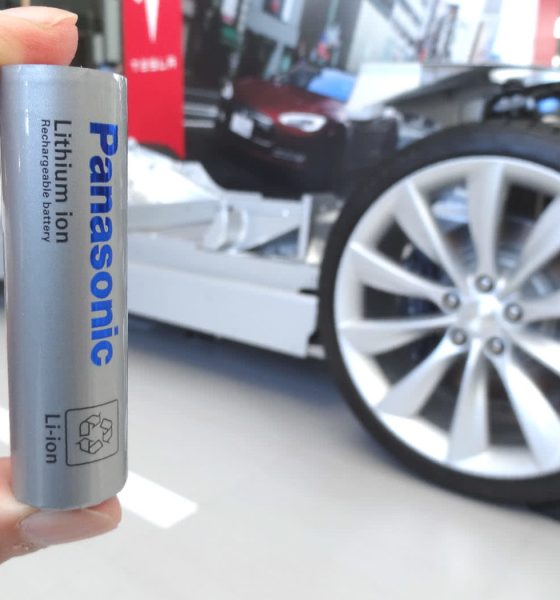

News
Tesla partner Panasonic’s US plans hint at possible Model S and X battery update
Tesla might be looking to expand its array of battery suppliers with the upcoming construction and operation of Gigafactory 3 in China, but its current exclusive battery supplier, Panasonic, is looking to double down on its partnership with the electric car maker nonetheless. In a recent statement to Japanese media, Panasonic announced that it plans to move its Tesla battery production facilities to the United States next year.
Panasonic already manufactures batteries for Tesla’s vehicles in the US in Gigafactory 1, though the cells it produces on the site are the 2170 cells being utilized for the Model 3. Tesla’s two flagship vehicles — the Model S and Model X — are still equipped with custom 18650 cells, which are produced by Panasonic in facilities located in Japan. Based on a report from the Nikkei Asian Review, these are the operations that the Japanese company will be bringing over to a “US-based unit starting next April.”
Considering that Panasonic is already producing 2170 cells for the Model 3 in Gigafactory 1, the company’s move of its Tesla battery production lines to a US-based facility could pave the way for a well-deserved and much-anticipated battery update for the Model S and X. The move, if any, provides Panasonic the opportunity to normalize its battery production for Tesla’s electric cars. It does not seem to be a strategic move for Panasonic, after all, to move its battery production operations to the United States to manufacture 18650 cells that are bound to be upgraded in the near future.
Tesla’s 18650 cells for the Model S and X, while not as energy-dense as the Model 3’s 2170 cells, still hold up well today. A recent range and efficiency test of the Jaguar I-PACE by German network nextmove, for example, showed that the Model X, which is equipped with 18650 cells, still seems to have superior battery tech than the newer electric crossover from the British carmaker. Elon Musk, for his part, lauded the Model 3’s 2170 cells in the third quarter earnings call, stating that the electric car currently stands as the “most energy efficient energy per mile electric vehicle out there.”
Tesla’s 2170 cells are hailed by industry experts as a difference-maker for the Silicon Valley-based company. Detroit veteran Sandy Munro, for one, noted after tearing down and analyzing the Model 3 that the electric car’s 2170 batteries are the best that he has seen to date. The potential of the 2170 cells could be seen in the Model 3 Performance’s recent Track Mode update, which allows the electric car to compete with the automotive industry’s best high-performance sedans on a closed circuit.
Elon Musk has noted that there is no such thing as a “full refresh” for its vehicles. In a statement on Twitter, Musk pointed out that Tesla’s electric cars are partially upgraded every month “as soon as a new subsystem is ready for production.” With this in mind, there seems to be little doubt that when the production of 2170 cells reaches a point where it is capable of supporting the Model S and X, Tesla will equip the vehicles with the larger, newer cells.
Both the Model S and Model X have defied the odds over the years, competing and even dominating their respective segments despite an abundance of skepticism and Tesla’s lack of experience in the auto industry. Considering that the vehicles are Tesla’s flagships, though, it stands to reason that both electric cars would be equipped with the best that the company has to offer — in terms of batteries, that pertains to the 2170 cells.

Elon Musk
Elon Musk and Tesla AI Director share insights after empty driver seat Robotaxi rides
The executives’ unoccupied tests hint at the rapid progress of Tesla’s unsupervised Robotaxi efforts.

Tesla CEO Elon Musk and AI Director Ashok Elluswamy celebrated Christmas Eve by sharing personal experiences with Robotaxi vehicles that had no safety monitor or occupant in the driver’s seat. Musk described the system’s “perfect driving” around Austin, while Elluswamy posted video from the back seat, calling it “an amazing experience.”
The executives’ unoccupied tests hint at the rapid progress of Tesla’s unsupervised Robotaxi efforts.
Elon and Ashok’s firsthand Robotaxi insights
Prior to Musk and the Tesla AI Director’s posts, sightings of unmanned Teslas navigating public roads were widely shared on social media. One such vehicle was spotted in Austin, Texas, which Elon Musk acknowleged by stating that “Testing is underway with no occupants in the car.”
Based on his Christmas Eve post, Musk seemed to have tested an unmanned Tesla himself. “A Tesla with no safety monitor in the car and me sitting in the passenger seat took me all around Austin on Sunday with perfect driving,” Musk wrote in his post.
Elluswamy responded with a 2-minute video showing himself in the rear of an unmanned Tesla. The video featured the vehicle’s empty front seats, as well as its smooth handling through real-world traffic. He captioned his video with the words, “It’s an amazing experience!”
Towards Unsupervised operations
During an xAI Hackathon earlier this month, Elon Musk mentioned that Tesla owed be removing Safety Monitors from its Robotaxis in Austin in just three weeks. “Unsupervised is pretty much solved at this point. So there will be Tesla Robotaxis operating in Austin with no one in them. Not even anyone in the passenger seat in about three weeks,” he said. Musk echoed similar estimates at the 2025 Annual Shareholder Meeting and the Q3 2025 earnings call.
Considering the insights that were posted Musk and Elluswamy, it does appear that Tesla is working hard towards operating its Robotaxis with no safety monitors. This is quite impressive considering that the service was launched just earlier this year.
Elon Musk
Starlink passes 9 million active customers just weeks after hitting 8 million
The milestone highlights the accelerating growth of Starlink, which has now been adding over 20,000 new users per day.

SpaceX’s Starlink satellite internet service has continued its rapid global expansion, surpassing 9 million active customers just weeks after crossing the 8 million mark.
The milestone highlights the accelerating growth of Starlink, which has now been adding over 20,000 new users per day.
9 million customers
In a post on X, SpaceX stated that Starlink now serves over 9 million active users across 155 countries, territories, and markets. The company reached 8 million customers in early November, meaning it added roughly 1 million subscribers in under seven weeks, or about 21,275 new users on average per day.
“Starlink is connecting more than 9M active customers with high-speed internet across 155 countries, territories, and many other markets,” Starlink wrote in a post on its official X account. SpaceX President Gwynne Shotwell also celebrated the milestone on X. “A huge thank you to all of our customers and congrats to the Starlink team for such an incredible product,” she wrote.
That growth rate reflects both rising demand for broadband in underserved regions and Starlink’s expanding satellite constellation, which now includes more than 9,000 low-Earth-orbit satellites designed to deliver high-speed, low-latency internet worldwide.
Starlink’s momentum
Starlink’s momentum has been building up. SpaceX reported 4.6 million Starlink customers in December 2024, followed by 7 million by August 2025, and 8 million customers in November. Independent data also suggests Starlink usage is rising sharply, with Cloudflare reporting that global web traffic from Starlink users more than doubled in 2025, as noted in an Insider report.
Starlink’s momentum is increasingly tied to SpaceX’s broader financial outlook. Elon Musk has said the satellite network is “by far” the company’s largest revenue driver, and reports suggest SpaceX may be positioning itself for an initial public offering as soon as next year, with valuations estimated as high as $1.5 trillion. Musk has also suggested in the past that Starlink could have its own IPO in the future.
News
NVIDIA Director of Robotics: Tesla FSD v14 is the first AI to pass the “Physical Turing Test”
After testing FSD v14, Fan stated that his experience with FSD felt magical at first, but it soon started to feel like a routine.

NVIDIA Director of Robotics Jim Fan has praised Tesla’s Full Self-Driving (Supervised) v14 as the first AI to pass what he described as a “Physical Turing Test.”
After testing FSD v14, Fan stated that his experience with FSD felt magical at first, but it soon started to feel like a routine. And just like smartphones today, removing it now would “actively hurt.”
Jim Fan’s hands-on FSD v14 impressions
Fan, a leading researcher in embodied AI who is currently solving Physical AI at NVIDIA and spearheading the company’s Project GR00T initiative, noted that he actually was late to the Tesla game. He was, however, one of the first to try out FSD v14.
“I was very late to own a Tesla but among the earliest to try out FSD v14. It’s perhaps the first time I experience an AI that passes the Physical Turing Test: after a long day at work, you press a button, lay back, and couldn’t tell if a neural net or a human drove you home,” Fan wrote in a post on X.
Fan added: “Despite knowing exactly how robot learning works, I still find it magical watching the steering wheel turn by itself. First it feels surreal, next it becomes routine. Then, like the smartphone, taking it away actively hurts. This is how humanity gets rewired and glued to god-like technologies.”
The Physical Turing Test
The original Turing Test was conceived by Alan Turing in 1950, and it was aimed at determining if a machine could exhibit behavior that is equivalent to or indistinguishable from a human. By focusing on text-based conversations, the original Turing Test set a high bar for natural language processing and machine learning.
This test has been passed by today’s large language models. However, the capability to converse in a humanlike manner is a completely different challenge from performing real-world problem-solving or physical interactions. Thus, Fan introduced the Physical Turing Test, which challenges AI systems to demonstrate intelligence through physical actions.
Based on Fan’s comments, Tesla has demonstrated these intelligent physical actions with FSD v14. Elon Musk agreed with the NVIDIA executive, stating in a post on X that with FSD v14, “you can sense the sentience maturing.” Musk also praised Tesla AI, calling it the best “real-world AI” today.








